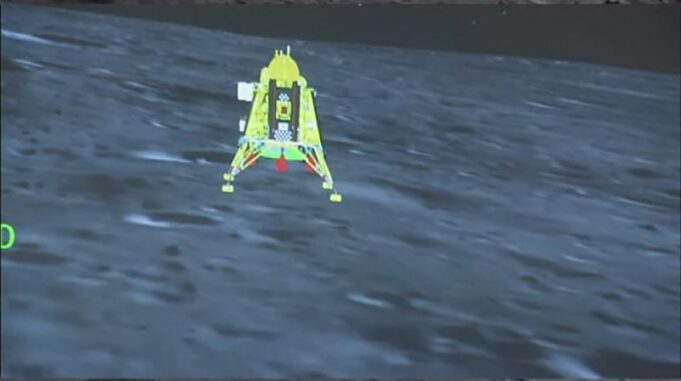An Indian Chandrayaan-3 spacecraft landed on the rugged and unexplored south pole of the moon on Wednesday, August 23, 2023, in a mission seen as crucial to lunar exploration and India’s standing as a space power.
This comes a few days after a similar Russian lander crashed.
“This moment is unforgettable. It is phenomenal. This is a victory cry of a new India,” Prime Minister Narendra Modi, who waved the Indian flag as he watched the landing from South Africa where he is attending a regional summit, said.
Scientists and officials clapped, cheered, and hugged each other as the spacecraft landed and people across India broke out in celebration, setting off firecrackers and dancing in the streets.
“India is on the moon,” said S. Somanath, chief of the Indian Space Research Organisation (ISRO) as the Chandrayaan-3 spacecraft landed.
India’s much-awaited moon mission Chandrayaan-3 has been scheduled for launch on July 14, 2023.
This was India’s second attempt to land a spacecraft on the moon and comes less than a week after Russia’s Luna-25 mission failed. People across the country were glued to television screens and said prayers as the spacecraft approached the surface.
READ ALSO: 288 die, 850 injured in India train crash
According to Reuters, nearly seven million watched the YouTube live stream.
Chandrayaan means “moon vehicle” in Hindi and Sanskrit. In 2019, ISRO’s Chandrayaan-2 mission successfully deployed an orbiter but its lander crashed.
The Chandrayaan-3 is expected to remain functional for two weeks, running a series of experiments including a spectrometer analysis of the mineral composition of the lunar surface.
The moon rover will take a few hours or a day to come out of the spacecraft, Somanath told reporters, adding that the landing has given India confidence to extend its reach to possible voyages to Mars and Venus.
The landing is expected to boost India’s reputation for cost-competitive space engineering. The Chandrayaan-3 was launched with a budget of about 6.15 billion rupees ($74 million), less than the cost to produce the 2013 Hollywood space thriller “Gravity”.
Rough terrain makes a south pole landing difficult, and a first landing is historic. The region’s ice could supply fuel, oxygen and drinking water for future missions.
“Landing on the south pole would actually allow India to explore if there is water ice on the moon. And this is very important for cumulative data and science on the geology of the moon,” said Carla Filotico, a partner and managing director at consultancy SpaceTec Partners.
India’s much-awaited moon mission Chandrayaan-3 has been scheduled for launch on July 14, 2023. The Soviet Union, the United States, and China are the only three countries that have successfully carried out soft landings on the moon.
Anticipation before the landing was feverish, with banner headlines across Indian newspapers and news channels running countdowns to the landing.
Prayers were held at places of worship across the country, and schoolchildren waved the Indian tricolour as they waited for live screenings of the landing.
- Governors: We’re reviewing sustainable minimum wage for workers - May 3, 2024
- UniAbuja ASUU faction dissociates self from strike - May 3, 2024
- Ex-PM Boris Johnson stopped from voting in UK election - May 3, 2024










